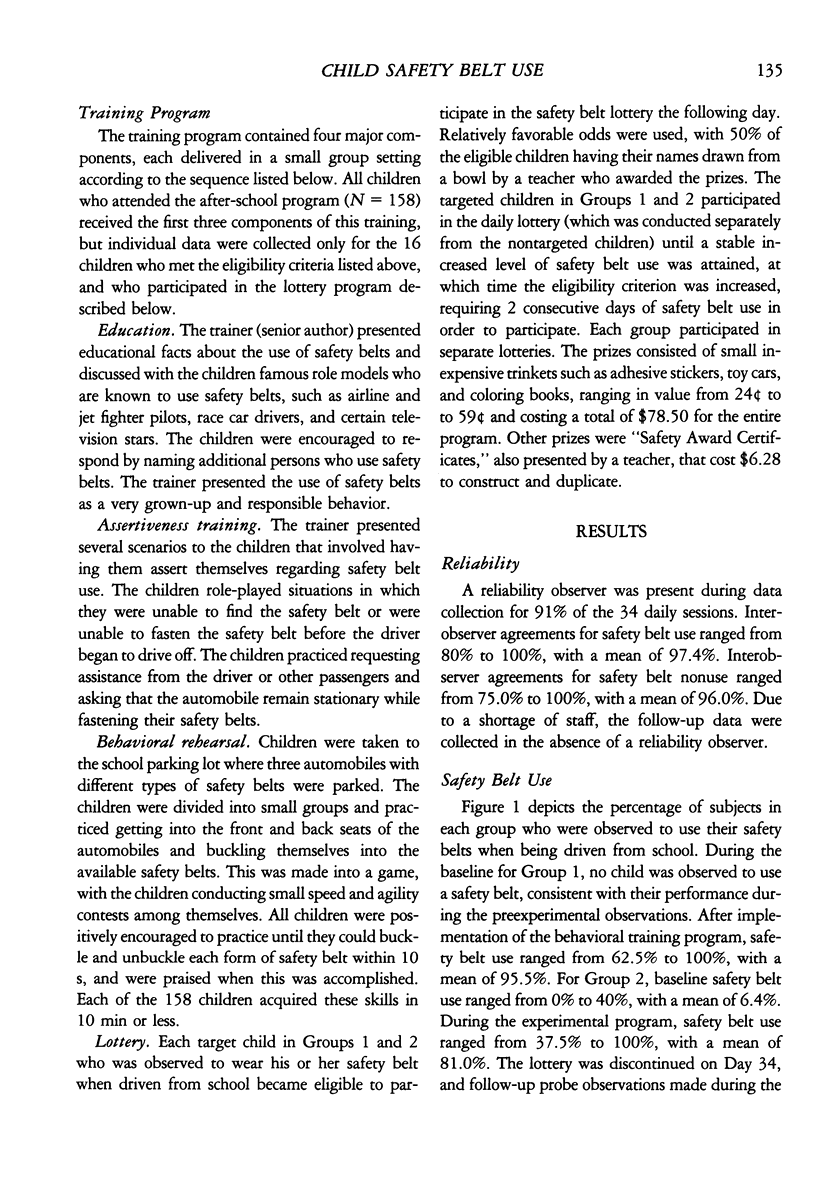Abstract
A program using behavioral practice, assertiveness training, and social and contrived reinforcers was developed to establish and maintain automobile safety belt use by young children. Sixteen children (ages 4.8 to 7 years) who never used their safety belts during a 5-day preexperimental observation period were randomly assigned to two groups of eight each. A multiple baseline design across groups was used to evaluate the effectiveness of the training program. During the 8-day baseline period for Group 1, no children used their safety belts when unobtrusively observed while being driven from school. During the 26-day intervention period, the children were buckled up on 96% of the observations. Follow-up probes conducted 2-3 months after program discontinuance found safety belt use to range from 86% to 100%. For Group 2, the 14-day baseline safety belt use averaged 6% and increased to a mean of 81% during the 20-day training and maintenance program. Follow-up probes 2-3 months later found safety belt use to occur during 75% to 96% of the observations. Parent questionnaires indicated the generalizability and social validity of the program.
Full text
PDF





Selected References
These references are in PubMed. This may not be the complete list of references from this article.
- Geller E. S., Bruff C. D., Nimmer J. G. "Flash for life": Community-based prompting for safety belt promotion. J Appl Behav Anal. 1985 Winter;18(4):309–314. doi: 10.1901/jaba.1985.18-309. [DOI] [PMC free article] [PubMed] [Google Scholar]
- Geller E. S., Casali J. G., Johnson R. P. Seat belt usage: A potential target for applied behavior analysis. J Appl Behav Anal. 1980 Winter;13(4):669–675. doi: 10.1901/jaba.1980.13-669. [DOI] [PMC free article] [PubMed] [Google Scholar]
- Jones R. T., Kazdin A. E., Haney J. I. Social validation and training of emergency fire safety skills for potential injury prevention and life saving. J Appl Behav Anal. 1981 Fall;14(3):249–260. doi: 10.1901/jaba.1981.14-249. [DOI] [PMC free article] [PubMed] [Google Scholar]
- Poche C., Brouwer R., Swearingen M. Teaching self-protection to young children. J Appl Behav Anal. 1981 Summer;14(2):169–175. doi: 10.1901/jaba.1981.14-169. [DOI] [PMC free article] [PubMed] [Google Scholar]
- Roberts M. C., Fanurik D. Rewarding elementary schoolchildren for their use of safety belts. Health Psychol. 1986;5(3):185–196. doi: 10.1037//0278-6133.5.3.185. [DOI] [PubMed] [Google Scholar]
- Roberts M. C., Turner D. S. Preventing death and injury in childhood: a synthesis of child safety seat efforts. Health Educ Q. 1984 Summer;11(2):181–193. doi: 10.1177/109019818401100209. [DOI] [PubMed] [Google Scholar]
- Roberts M. C., Turner D. S. Rewarding parents for their children's use of safety seats. J Pediatr Psychol. 1986 Mar;11(1):25–36. doi: 10.1093/jpepsy/11.1.25. [DOI] [PubMed] [Google Scholar]
- Swain J. J., Allard G. B., Holborn S. W. The good toothbrushing game: a school-based dental hygiene program for increasing the toothbrushing effectiveness of children. J Appl Behav Anal. 1982 Spring;15(1):171–176. doi: 10.1901/jaba.1982.15-171. [DOI] [PMC free article] [PubMed] [Google Scholar]
- Yeaton W. H., Bailey J. S. Teaching pedestrian safety skills to young children: an analysis and one-year followup. J Appl Behav Anal. 1978 Fall;11(3):315–329. doi: 10.1901/jaba.1978.11-315. [DOI] [PMC free article] [PubMed] [Google Scholar]


